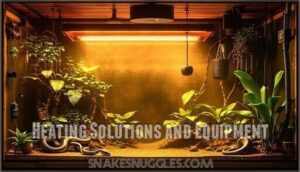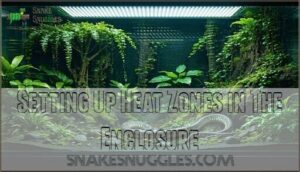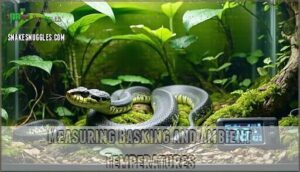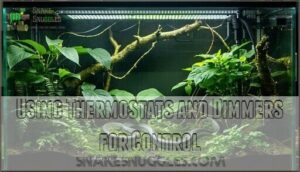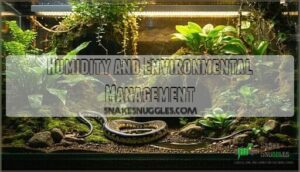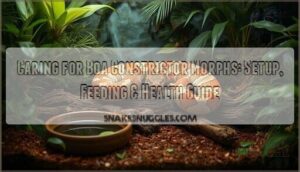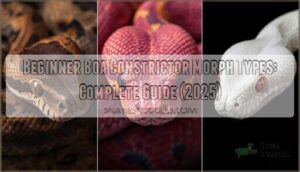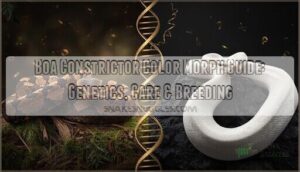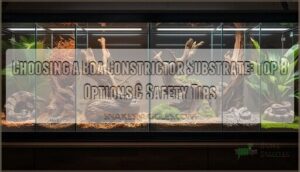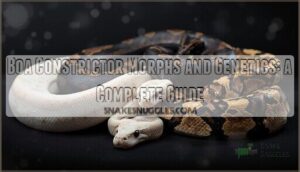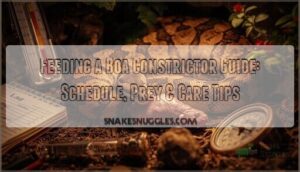This site is supported by our readers. We may earn a commission, at no cost to you, if you purchase through links.
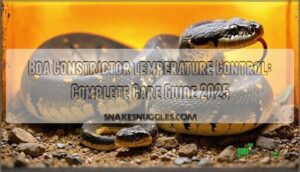 A boa constrictor raised at 30°C reaches 9.6 kilograms, while one kept at 23°C plateaus at 5.9 kilograms—same genetics, same feeding schedule, wildly different outcomes. Temperature doesn’t just influence your snake’s comfort; it fundamentally shapes growth trajectories, digestive efficiency, and immune response.
A boa constrictor raised at 30°C reaches 9.6 kilograms, while one kept at 23°C plateaus at 5.9 kilograms—same genetics, same feeding schedule, wildly different outcomes. Temperature doesn’t just influence your snake’s comfort; it fundamentally shapes growth trajectories, digestive efficiency, and immune response.
Most keepers know boas need warmth, but the difference between adequate and ideal spans the gap between a thriving animal and one that merely survives.
Creating the right thermal environment means understanding how infrared radiation penetrates tissue, why basking zones trigger metabolic cascades, and which heating technologies deliver results without introducing risks. Master these principles, and you’ll transform your enclosure from a glass box into a carefully calibrated microclimate that sustains every physiological process your boa depends on.
Table Of Contents
Key Takeaways
- Temperature differentials of just 6-7°C (23°C vs 30°C) produce drastically different growth outcomes in boa constrictors—identical genetics and feeding schedules can yield animals weighing 5.9 kg versus 9.6 kg over four years, demonstrating that thermal management directly controls metabolic efficiency, digestive capacity, and developmental trajectories.
- Establishing a functional thermal gradient (88-90°F basking zones with 75-80°F cool ends) isn’t optional decoration—it’s the physiological foundation that allows boas to self-regulate body temperature for optimal immune function, digestion timing, and cellular processes that peak at 30-34°C.
- Halogen flood lamps and deep heat projectors outperform ceramic emitters by delivering infrared-B and infrared-C radiation that penetrates tissue depth, mimicking natural solar basking while creating directional heat emission that builds precise gradients without dangerous hotspots.
- Temperature monitoring requires calibrated instruments (infrared thermometers, digital thermostats with probes) placed at multiple gradient zones—basking surface, ambient warm side, and cool end—because management depends on measurement accuracy, and unchecked thermal drift causes respiratory infections, incomplete sheds, and metabolic collapse regardless of enclosure size or décor quality.
Temperature Requirements for Boa Constrictors
Getting your boa’s temperature right isn’t guesswork—it’s about understanding what these snakes need to thrive. Temperature directly affects digestion, immune function, and growth, so you’ll want to nail the basics before setting up your enclosure.
Let’s break down the specific requirements that’ll keep your boa healthy and comfortable.
Ideal Temperature Range and Gradient
Your boa constrictor’s thermal landscape—the hot-to-cool temperature span across its enclosure—isn’t just a nice-to-have feature, it’s the cornerstone of successful husbandry.
You’ll want to establish an ideal temperature range with basking spots reaching 88-90°F while ambient control maintains the cool end at 75-80°F.
This thermal gradient lets your snake shuttle between heat sources for precise temperature control—essential for proper boa constrictor care and preventing dangerous temperature fluctuation.
Effects of Temperature on Health and Growth
Temperature directly shapes every aspect of your boa’s biology, from metabolism to immune function. Proper temperature control isn’t optional—it’s fundamental boa constrictor care that determines whether your snake thrives or merely survives. Understanding the boa’s tropical climate needs is vital for creating an ideal environment.
Here’s what thermal regulation controls:
- Growth patterns—boas raised at 30°C reach 9.6 kg versus just 5.9 kg at 23°C over four years
- Digestive efficiency—warmer temperatures (30°C) accelerate digestion and reduce energy waste
- Immune competence—ideal cellular function occurs at 30-34°C, affecting disease resistance
- Feeding cycles—warmer conditions shorten intervals between meals and boost activity levels
Risks of Incorrect Temperature
When temperatures stray outside the 75–90°F range, your boa faces serious consequences. Temperature stress weakens immune function, opening the door to respiratory issues and metabolic problems. Overheating causes thermal burns and lethargy, while cold conditions slow digestion dangerously. Here’s what goes wrong:
| Temperature Problem | Health Risks | Visible Signs |
|---|---|---|
| Too Cold (90°F) | Thermal burns, organ stress | Gaping mouth, attempting escape |
| No Gradient | Inability to thermoregulate | Constant restlessness, digestive issues |
Proper boa constrictor care depends on reliable temperature and heating systems that support natural thermal regulation throughout your enclosure. To achieve this, understanding temperature gradient requirements is essential for creating a suitable environment.
Heating Solutions and Equipment
Choosing the right heating equipment is essential for creating a stable thermal gradient in your boa’s enclosure. You’ll need to match the heat source to your specific setup, considering both daytime and nighttime needs.
Let’s look at the most effective options for maintaining ideal temperatures.
Halogen Bulbs and Flood Lamps
Halogen flood lamps mimic the sun’s natural warmth better than any other artificial heat source, making them the preferred choice for creating a proper thermal gradient in your boa’s enclosure.
You’ll need dual dome-style lamp fixtures with ceramic sockets—avoid cheap plastic versions that can’t withstand the heat output. PAR38 halogen flood bulbs provide excellent heat distribution across the basking zone, and clustering at least two heat bulbs creates that essential gradient without tight hotspots.
Deep Heat Projectors and Ceramic Emitters
Deep Heat Projectors represent the evolution of reptile heating technology—they deliver focused infrared-B and -C radiation without visible light, making them an advanced alternative to traditional ceramic heat emitters for maintaining your boa’s thermal gradient.
Deep Heat Projectors deliver focused infrared radiation without visible light, representing an evolutionary leap in reptile heating technology
DHPs outperform ceramic elements in several key ways:
- Deeper tissue penetration through infrared heating mimics natural basking
- Directional heat emission creates precise temperature gradients
- Lower surface temperatures reduce burn risks compared to ceramic heat emitters
- Exceptional energy efficiency for long-term radiant panel heating
Both devices work with standard ceramic sockets and thermostats for controlled reptile heating.
Nighttime Heating Options
When daylight fades and your halogen bulbs switch off, your boa still needs reliable warmth to maintain proper metabolic function throughout the night. Ceramic emitters and radiant panels excel here—they produce infrared heating without light emission, preserving natural nighttime cycles while maintaining your temperature gradient. Connect your heat source to a thermostat for precise nighttime temperature control.
| Heat Source | Best For |
|---|---|
| Ceramic Emitters | Localized heat emission in smaller enclosures |
| Radiant Heat Panels | Even heat distribution across larger spaces |
| Deep Heat Projectors | Enhanced infrared heating with tissue penetration |
| Heat Lamp (covered) | Emergency backup when primary systems fail |
| Thermostat Settings | Automated nighttime temperature regulation |
Product Recommendations (Lutron Dimmer, Infrared Thermometer)
Precision equipment transforms guesswork into reliable climate control, giving you the confidence to maintain perfect conditions without constant second-guessing.
A Lutron dimmer switch paired with your heat lamp lets you fine-tune basking temperatures with surgical accuracy.
Infrared thermometers provide instant surface readings across your temperature gradient, while digital thermostats with temperature probes guarantee your heat source maintains consistent ambient zones without manual intervention.
Creating and Maintaining a Temperature Gradient
Building a proper temperature gradient isn’t guesswork—it requires deliberate placement of heat sources and consistent monitoring to guarantee your boa can move between thermal zones as needed.
You’ll need to understand where to position equipment, how to verify temperatures accurately, and what tools keep everything stable.
Let’s break down the three critical components that transform your enclosure into a functional thermoregulatory environment.
Setting Up Heat Zones in The Enclosure
Creating a proper thermal landscape in your boa’s enclosure isn’t about slapping a heat lamp on one side and calling it a day—you’re designing a microclimate that mirrors the natural temperature variation these snakes experience as they move between sun-drenched basking spots and shaded retreats.
Position your heat source (halogen flood lamp or deep heat projector) at one terminus of the enclosure, concentrating warmth to establish a distinct thermal gradient. Use a thermostat to prevent temperature spikes, and arrange decor to create stratified heat zones—open basking surfaces directly beneath the lamp, transitional zones at mid-distance, and cool refugia at the opposite end.
This heat zone management facilitates precise temperature control through selective thermoregulation, supporting digestion and metabolic function while preventing thermal stress.
Measuring Basking and Ambient Temperatures
You can’t manage what you don’t measure—and regarding boa constrictor husbandry, accurate temperature monitoring separates thriving snakes from those battling chronic stress and digestive complications. Deploy infrared thermometers for non-contact basking spot verification and digital thermostats with probe thermometer placement in the thermal gradient zones you’ve created:
- Basking surface temperature: 88-92°F measured directly on substrate
- Ambient warm side: 82-85°F at mid-enclosure height
- Cool side: 75-80°F opposite the heat source
- Temperature logging: Track daily ranges to confirm gradient stability
Calibrate your equipment monthly against a certified reference thermometer—temperature control precision depends on measurement accuracy.
Using Thermostats and Dimmers for Control
Without proper control mechanisms in place, even the most carefully monitored temperature gradient can drift dangerously—that’s where thermostats and dimmers become your first line of defense against thermal mismanagement.
Install proportional thermostats connected to temperature probes positioned at basking surfaces, enabling precise heat cycling within your target temperature range. Dimmer controls like the Lutron dimmer fine-tune heating elements, preventing thermal overshoots while maintaining stable thermal gradients.
Smart sensors provide real-time feedback, ensuring your thermostat settings respond dynamically to ambient fluctuations.
Humidity and Environmental Management
Temperature control isn’t the whole story—humidity and ventilation play just as critical a role in keeping your boa healthy. Get these environmental factors wrong, and you’ll face shedding problems and respiratory infections no matter how perfect your heat gradient is.
Here’s what you need to know about maintaining the right humidity levels, choosing ventilation-friendly substrates, and preventing the most common health issues.
Maintaining Optimal Humidity Levels
Humidity sits at the heart of successful boa constrictor husbandry—get it wrong, and you’re looking at stuck sheds, respiratory infections, and a stressed snake that can’t thrive. You’ll want to maintain humidity levels between 50-60% using a calibrated hygrometer—not guesswork.
Large water bowls provide passive humidity, while misting schedules and fogging systems let you fine-tune conditions during shedding cycles.
Enclosure Ventilation and Substrate Choices
Stagnant air breeds bacteria, and the wrong substrate can trap moisture like a soggy sponge—both spell disaster for your boa’s respiratory system.
You’ll need cross-ventilation through the enclosure’s sides or top—not just screened lids—to maintain airflow management without sacrificing humidity control.
Cypress mulch, coconut husk, and reptile-safe soil offer moisture retention with breathability, while non-particulate options like newspaper simplify enclosure hygiene monitoring.
Preventing Respiratory and Shedding Issues
Once your ventilation and substrate work in tandem, temperature control becomes your frontline defense against the two most common captive boa ailments.
Enclosure temperatures consistently below 75°F dramatically increase respiratory infection risk—over half of documented cases with temps under 70°F showed open-mouthed breathing or nasal discharge.
During the shedding process, maintaining 86–90°F basking zones with 75–85% humidity ensures complete sheds, as 94% of incomplete sheds correlate with suboptimal thermal gradient or moisture levels.
Enclosure Design for Boa Constrictor Wellbeing
Your boa’s enclosure isn’t just a box—it’s the foundation for everything from thermoregulation to stress-free living. Getting the size, layout, and furnishings right means your snake can actually use that temperature gradient you’ve worked so hard to create.
Let’s break down what makes an enclosure functional, safe, and easy to maintain.
Sizing and Layout for Thermoregulation
Think of a boa’s enclosure as a thermal landscape—one where the architecture itself becomes a tool for survival, enabling your snake to self-regulate just as it would across miles of rainforest floor.
Proper enclosure dimensions create effective thermal zones: for a 4-foot boa, you’ll need at least 4 x 2 x 2 feet of space allocation to establish a functional temperature gradient.
Your layout planning should position heat sources strategically, allowing your snake to move freely between temperature ranges without compromising thermoregulation efficiency or temperature control.
Safe and Functional Decor Items
Every branch, hide, and water bowl you place fulfills dual purposes—shelter for security and strategic tools for thermal navigation. Position hide boxes at both thermal extremes so your boa can retreat while maintaining its preferred temperature.
Climbing branches and decorative rocks become basking platforms when placed beneath heat sources, while plants and foliage act as visual barriers that reduce stress without blocking airflow—essential for microclimate stability within your enclosure decor layout.
Cleaning, Monitoring, and Seasonal Adjustments
Routine maintenance isn’t just housekeeping—it’s your early warning system for detecting subtle shifts in thermal stability, humidity drift, and emerging health concerns before they escalate into clinical problems.
Weekly enclosure maintenance integrates temperature logging, humidity monitoring, and disinfection methods into a cohesive cage cleaning schedule that tracks environmental consistency:
- Temperature and humidity control checks using infrared thermometers
- Substrate replacement to maintain proper humidity levels
- Disinfection methods targeting bacterial colonization zones
- Seasonal cycles documentation adjusting your temperature range across photoperiods
Frequently Asked Questions (FAQs)
Can boa constrictors tolerate temporary temperature drops?
Yes, boas can tolerate brief temperature drops, but sustained exposure below 75°F triggers cold stress and compromises immune function.
Their thermal tolerance narrows quickly—adaptation strategies matter less than maintaining your temperature range consistently through proper monitoring.
How quickly do enclosures cool at night?
Cooling Dynamics depend heavily on Thermal Mass and Insulation Effects—glass tanks lose heat faster than PVC enclosures.
Ambient Drops of 5–10°F occur within 2–3 hours without supplemental heating, affecting your temperature gradient and temperature range stability.
Monitor Nighttime Cooling Rates with infrared tools.
What temperatures trigger brumation in boas?
Like a thermostat signaling winter’s arrival, temperatures consistently below 70°F (21°C) can trigger brumation in Boa Constrictors. While true hibernation patterns don’t occur in captive boas, prolonged cold stress from temperature fluctuations outside their ideal temperature range disrupts normal metabolism and activity levels.
Do different boa morphs need different temperatures?
All boa constrictor morphs—whether hypomelanistic, albino, or wild-type—require identical thermal parameters. Morph genetics affect color variants and scale patterns, not thermoregulatory physiology.
Temperature requirements remain consistent: 88-92°F basking zones and 78-82°F ambient areas, regardless of phenotype expression.
How does room temperature affect enclosure heating?
Ironically, you can’t ignore what’s happening outside the glass—ambient temperature directly influences thermal dynamics within your boa’s enclosure.
Warmer rooms reduce heating demands, while cooler spaces require stronger heat sources to maintain proper gradients and offset heat transfer losses through enclosure walls.
Conclusion
Thermoregulation drives every physiological cascade in your boa’s body—a 6°C shift can alter metabolic rate by 40%, transforming a vigorous feeder into a lethargic recluse. Mastering boa constrictor temperature control means translating thermal physics into living biology: infrared penetration depth, gradient precision, and equipment reliability converge to create microclimates that sustain growth, digestion, and immune function.
Your thermometer readings aren’t abstract numbers—they’re the difference between thriving and merely existing. Calibrate with purpose, monitor with discipline, and watch physiology unfold exactly as evolution designed.
- https://reptifiles.com/boa-constrictor-care/boa-constrictor-temperatures/
- https://arborviewah.com/wp-content/uploads/2023/03/Boa-ConstrictorRed-Tailed-Boa-Guide.pdf
- https://www.sciencedirect.com/science/article/abs/pii/S0306456507000903
- https://www.jstor.org/stable/3890992
- https://pubmed.ncbi.nlm.nih.gov/7322848/

